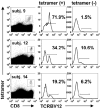Public TCR use by herpes simplex virus-2-specific human CD8 CTLs
- PMID: 20139278
- PMCID: PMC2863070
- DOI: 10.4049/jimmunol.0903622
Public TCR use by herpes simplex virus-2-specific human CD8 CTLs
Abstract
Recombination of germline TCR alpha and beta genes generates polypeptide receptors for MHC peptide. Ag exposure during long-term herpes simplex infections may shape the T cell repertoire over time. We investigated the CD8 T cell response to HSV-2 in chronically infected individuals by sequencing the hypervariable regions encoding TCR alpha and beta polypeptides from T cell clones recognizing virion protein 22 aa 49-57, an immunodominant epitope. The most commonly detected TCRBV gene segment, found in four of five subjects and in 12 of 50 independently derived T cell clones, was TCRBV12-4. Nineteen to seventy-two percent of tetramer-binding cells in PBMCs were stained ex vivo with a TCRBV12 mAb. Three alpha-chain and three beta-chain public TCR sequences were shared between individuals. Public heterodimers were also detected. Promiscuous pairing of a specific TCRVA1-1 sequence with several different TCRB polypeptides was observed, implying a dominant structural role for the TCRA chain for these clonotypes. Functional avidity for cytotoxicity and IFN-gamma release was relatively invariant, except for one subject with both high avidity and unique TCR sequences and lower HSV-2 shedding. These data indicate that the CD8 response to a dominant alpha-herpesvirus epitope converges on preferred TCR sequences with relatively constant functional avidity.
Figures





References
-
- Speck P, Simmons A. Precipitous clearance of herpes simplex virus antigens from the peripheral nervous systems of experimentally infected C57BL/10 mice. J Gen Virol. 1998;79:561–564. - PubMed
-
- Wakim LM, Waithman J, van Rooijen N, Heath WR, Carbone FR. Dendritic cell-induced memory T cell activation in nonlymphoid tissues. Science. 2008;319:198–202. - PubMed
Publication types
MeSH terms
Substances
Associated data
- Actions
- Actions
- Actions
- Actions
- Actions
- Actions
- Actions
- Actions
- Actions
- Actions
- Actions
- Actions
- Actions
- Actions
- Actions
- Actions
- Actions
- Actions
- Actions
- Actions
- Actions
- Actions
- Actions
- Actions
- Actions
- Actions
- Actions
- Actions
- Actions
- Actions
- Actions
- Actions
- Actions
- Actions
- Actions
- Actions
- Actions
- Actions
- Actions
- Actions
- Actions
- Actions
- Actions
- Actions
- Actions
- Actions
- Actions
- Actions
- Actions
- Actions
- Actions
- Actions
- Actions
- Actions
- Actions
- Actions
- Actions
- Actions
- Actions
- Actions
- Actions
- Actions
- Actions
- Actions
- Actions
- Actions
- Actions
- Actions
- Actions
- Actions
- Actions
- Actions
- Actions
- Actions
- Actions
- Actions
- Actions
- Actions
- Actions
- Actions
- Actions
- Actions
- Actions
- Actions
- Actions
- Actions
Grants and funding
LinkOut - more resources
Full Text Sources
Other Literature Sources
Molecular Biology Databases
Research Materials

